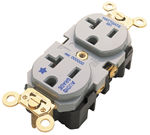HT Boot Camp: AC Power Page 2
 Next, make sure that your RF (antenna or cable) system is properly grounded. Testing this basically amounts to disconnecting the RF cable from the system. If the ground loop goes away, the RF signal needs to be grounded, preferably at the point where it enters the building. A qualified cable technician or electrician should do this. An antenna or cable system is one of the most common sources of ground loops.
Next, make sure that your RF (antenna or cable) system is properly grounded. Testing this basically amounts to disconnecting the RF cable from the system. If the ground loop goes away, the RF signal needs to be grounded, preferably at the point where it enters the building. A qualified cable technician or electrician should do this. An antenna or cable system is one of the most common sources of ground loops.
If you're sure the electrical and RF systems are wired correctly, check to see if your A/V equipment is connected with proper polarity. Manufacturers may not have wired the two-prong plugs on their equipment properly, so you may need to reverse the plug at the outlet in order for the equipment's hot and neutral leads to match those of the outlet. You can determine this, again, with a voltmeter by measuring the difference between the equipment-chassis ground (via a ground lug or chassis screw) and the outlet's ground termination. On some units, the audio and video connector ground may be floating from the chassis ground. Reverse the plug and measure again. Since one of the two prongs is wider, you'll want to use "cheater" plugs. These are three-prong-to-two-prong adapters that don't usually have the polarized prong (or have one that can be filed down), which means you won't permanently damage your equipment (or void the warranty). The adapter costs about a buck and can be found at any electrical-supply or hardware store. The connection with the lowest measurement is correct. You can also measure polarity with Audio Advisor's Elfix, a gray handheld device that beeps and illuminates when the polarity is incorrect. Keep in mind, however, that you can only measure for correct polarity when no other connections are made to the equipment. Checking for polarity is easy when you're assembling a new system. The fact that everything must be disconnected for the test to work makes it a tremendous hassle for systems—particularly, complex systems—that are already connected. It's worth the effort, though.
Only as a last resort should you lift grounds on three-pronged equipment. This is never a good solution. For one, the ground pin is there for safety. Also, the problem may or may not be with a grounded component. Finally, when too many grounds are lifted (or if the entire system's ground is lifted), the system can exhibit excessive static or background noise. Sometimes, however, convenience is necessary. First, determine which components are causing the ground loop. Start at one end of the equipment chain and work your way to the other. Does the volume control affect the level of the hum? If so, it's a ground loop before the amp; if not, it's a ground loop with the amp (or with a powered speaker, like a subwoofer). Start by lifting the ground on only one component at a time, working your way through each component. Then try combinations of two components at a time, and so on. If the only way to clear the system of buzzes and hums is to lift the ground on the entire system, you're better off starting over.
Of course, you should always use caution with electricity. Wear rubber boots, don't stand in puddles, and don't grip exposed electrical lines with both hands. Just don't take electricity for granted. You can spend all you want on your audio and video components; however, if you ignore your electrical system, you may have wasted your hard-earned cash. On the other hand, taking stock of your available power and making sure your system is connected properly will keep you safe from harm and ensure that everything is working as it should.




























































